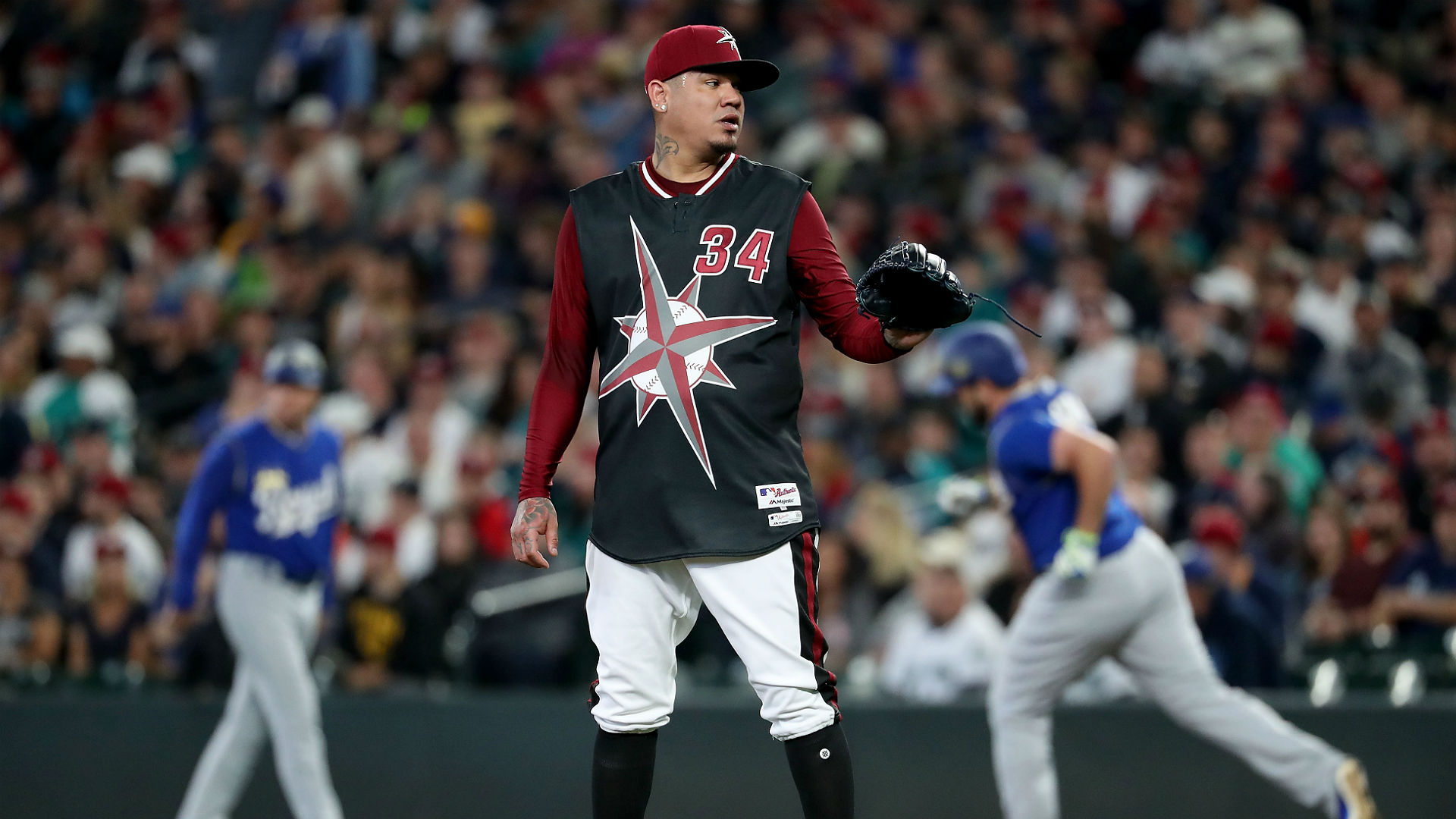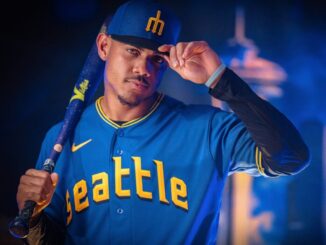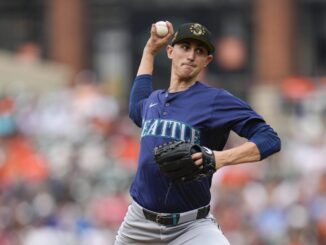
As Spring Training begins to wind down, with just over a week until the start of the season, the time to look at the Seattle Mariners starting rotation draws nigh. Despite some nagging injuries that well may alter the makeup of the rotation on opening day, the most likely starting five for the long haul are James Paxton, Mike Leake, Felix Hernandez, Erasmo Ramirez, and Marco Gonzales, with sprinklings of Ariel Miranda, Hisashi Iwakuma, and Andrew Moore to top it off.
If the Mariners can limit the number of starters in 2018 to just these eight, they will be light years ahead of last season when they led all of major league baseball with a whopping seventeen different pitchers taking the mound in the first inning of games. As a result of the instability in the rotation – no Mariner pitcher started as many as 30 games – the Mariners pitching staff finished 23rd in fWAR with 9.8 in 2017, ahead of just the Atlanta Braves, Texas Rangers, Baltimore Orioles, San Diego Padres, Miami Marlins, Chicago White Sox, and the Cincinnati Reds.
With no disrespect intended to any of those fine organizations or the cities they proudly represent (well maybe not the Marlins), none of those teams were expected to make a run at the playoffs in 2017 (maybe Texas? maybe Baltimore? Eh?) but the Mariners were wildcard favorites last preseason. A major contributing factor to the 78-win fiasco that ensued was the inability of key members of the starting rotation to stay healthy. To put it perspective, while the entire Mariners rotation notched 9.8 fWAR (Fangraphs version of WAR), Chris Sale of the Boston Red Sox accumulated 7.7 fWAR by himself.
So, in 2018 as always, health will be one important key to the Mariners success. Here’s a glimpse at what some of the projection models foresee for the starting rotation.
James Paxton
In 2017, James Paxton made 24 starts and ate up 136 innings for a 12-5 record with a 2.98 ERA. His FIP (fielding independent pitching) of 2.61 indicated that Paxton was even a tad better than his ERA showed. Of the lowly 9.8 fWAR by the entire staff, Paxton accounted for nearly half, with a fWAR of 4.6.
It would be nice to think that Paxton could start 30 or more games in 2018, but, more and more, that seems like wishful thinking. Paxton is not a young up and comer anymore. He turned 29 in November and has never pitched more than 169.2 innings in a single season of professional baseball. In his rookie season back in 2013, he pitched 145.2 innings in AAA and an additional 24 innings in the majors. Last season was his high-water mark for innings in the bigs.
The various projection systems reflect the skepticism surrounding Paxton’s ability to stay healthy for a whole season. Steamer is the most bullish on Paxton with a projection of 29 starts and 175 innings. ZiPS, however, sees almost a carbon copy of 2017, expecting 25 starts and 134 innings. Two of the other major projection systems used on Fangraphs, Depth Charts and Fans, expect something between those two extremes.
It’s expected that projection systems will vary somewhat as they are each predicated on slightly different models. For instance, Steamer sees Paxton putting up a 3.54 ERA, the highest of the four, while Fans projects a 3.14 ERA, the lowest of the four. With WAR, Steamer and ZiPS both see Paxton as almost a four-win player (3.7 WAR), whereas Fans sees a five-win player (5.2 WAR). While a single win, much less 1 ½ wouldn’t have made much difference in 2017, it would have ensured at least a single game playoff in 2016.
Barring a major bounce back to the form of three seasons ago by Felix Hernandez, James Paxton is the “ace” of the staff. If the Mariners are to compete for a playoff spot he’ll need to pitch like an “ace,” and part of that is taking the bump every fifth day for the entire season. The track record on that kind of stamina and health has been spotty. Can 2018 be different? We’ll start to find out in about a week.
Mike Leake
Mike Leake was acquired from the St. Louis Cardinals in early August of last season. Had the thirty-year-old right hander begun the season with the Mariners, he would have been the only pitcher to start over 30 games, 31 to be exact. Between the Cardinals and the Mariners, Leake went 10-13 in 31 starts and 186 innings, with a 3.92 ERA, similar FIP of 3.90, and accounted for 3.1 fWAR.
Leake is the epitome of durability with six consecutive seasons of 30 or more starts during tours of duty with the Cincinnati Reds, San Francisco Giants, St. Louis Cardinals, and now the Seattle Mariners.
True to form, both Depth Charts and Steamer project Leake for 31 starts, while the ever-conservative ZiPS projects 28 starts. Predicted innings vary between 186 by Steamer to 165 innings by ZiPS. Either innings projection would have led the Mariners last season, so Leake looks to be this season’s workhorse.
Continuing the metaphor, Mariners fans shouldn’t expect a thoroughbred racehorse on the mound in Leake, just a reliable innings eating workhorse. With a career 3.98 ERA, all in the NL except the 5 starts last season with the M’s, Leake is projected to have an ERA somewhere between the Fans projected 3.75 and the Steamer projected 4.58. WAR totals also vary from between 3.3 from Fans to 1.8 from Steamer.
There’s nothing flashy about Mike Leake, but in 2018 he could easily be the most reliable pitcher in the Mariners rotation.
Felix Hernandez
If everything goes according to plan, with no setbacks in recovery from the line drive off the forearm in Spring Training, Felix Hernandez should be the opening day starter for the Seattle Mariners for the tenth consecutive season. Fun fact. Hernandez was the opening day starter in 2007 also, but was sub planted by Erik Bedard – remember him? – in 2008. Otherwise, it would be twelve straight opening starts.
But, make no mistake. Pitching in the first game of the season doesn’t make Felix the ace of the staff. James Paxton has the highest upside of the starting rotation but lacks the track record of endurance that a true “ace” would have. So, this staff may not actually have an ace pitcher, in the classic sense of the term, but, for sure, Felix is three years removed from any such status.
The King will turn thirty-two on April 8th and is coming off a season that saw him pitch only 86.2 innings. In 16 starts in 20017, Felix went 6-5 with a middling 4.36 ERA and a worse 5.02 FIP but encouraging xFIP of 4.03, to account for 0.4 fWAR. The previous season was better, but still not King like, with 25 starts, 153.1 innings, for an 11-8 record, 3.82 ERA, but 4.63 FIP, and a 1.0 fWAR.
The velocity on Hernandez’s fast ball has been trending down for years. From his peak in 2007 of 98.5 mph, the last two seasons the fastball has been sub-92 mph – 91.1 in 2016 and 91.2 in 2017. Now pitchers can live in the low 90’s. The problem with Felix has been the velocity differential of his out pitches. Back in 2007, the differential in his fastball and his changeup was close to ten mph. Last season his fastball was an average of 91.2 mph, but his change was 86.3.
Pitchers lose velocity as they get older. It’s just a fact. The question is how do they adjust? If you’re Justin Verlander, you date Kate Upton, get the velocity back, and go win a World Series. If you’re CC Sabathia, you learn to locate and outpitch opponents. It’s still to be seen how Felix will adjust. All reports are that Hernandez looked good in Spring Training, up until he took a liner off the forearm, and looked good in a start this week, so who knows?
The projections range from 28 starts from both Depth Charts and Steamer to 22 starts from ZiPS. The years of 200+ innings seem over, as Steamer places Hernandez at 162 innings and ZiPS places him at 124. All the projection models tend to see the thirty-two-year-old version of King Felix as a competent, middle of the rotation guy, with ERA’s ranging from 4.38 by Steamer to 3.88 by Fans. Everyday contribution of anywhere from 1.5 WAR by ZiPS to 2.0 WAR by Steamer is what is expected from the former Cy Young award winner.
Erasmo Ramirez
Erasmo Ramirez, who will turn twenty-eight in May, was re-acquired from the Tampa Rays in late July of last season. He has been hampered by a lat injury and has only recently begun throwing in Spring Training. But if all goes well, Ramirez is projected to make his 2018 debut in mid to late April.
In 2017, Ramirez made 19 starts, going 5-6 in 131.1 innings, with a 4.39 ERA, 4.43 FIP, and a 1.1 fWAR. Back in 2015 with the Rays, playing primarily against the formidable AL East, Ramirez was quite the pleasant surprise. In his age twenty-five season, he started 27 games, won 11, and had an ERA+ of 104, slightly better than league average in a tough hitting division. Pitching out of the bullpen over most of 90.2 innings the next season, Ramirez bested that mark with a ERA+ of 106. Unfortunately, he’s been under league average since. A bounce back to 2015-2016 form by Ramirez could be huge for the Mariners back of the rotation.
Depth Charts and Steamer both project 23 starts, with, as usual, ZiPS painting a gloomier picture with 13 projected starts. Innings range from 140.2 by Fans to 113.0 by ZiPS. In a reverse of trends, Steamer projects a 4.80 ERA, whereas ZiPS is actually the most optimistic with a projected 4.06 ERA. Finally, Ramirez is almost universally thought of as a one-win player. Steamer has Ramirez at 0.9 WAR for 2018, on the low end, while Depth Charts expects a 1.3 WAR on the high end.
Marco Gonzales
Bringing up the back end of the rotation should be the youngster of the group, Marco Gonzales, who just turned twenty-six in February. Gonzalez was acquired from the Cardinals in late July last season. (Noticing a trend here?)
Coming off Tommy John surgery, Gonzales made his big-league debut with the Cardinals in 2015. He made 8 starts in 2017, pitched exactly 40.0 innings, with a not so impressive 6.08 ERA. His FIP indicates that 6+ ERA may be a little noisy in such a small sample size, as it came in a full run lower at 5.06. He accounted for 0.1 fWAR.
For this season, Fans and ZiPS project 21 starts at the ceiling, while Steamer projects 18 starts at the floor. Gonzales could account for anywhere between 130 innings, as seen by Fans, or 107 innings, as projected by Steamer. All projection systems see a lower ERA than last season, ranging from 4.70 on the high end per ZiPS to 4.18 on the low end per Fans. Of the most optimistic, Fans also projects Gonzales contributing 1.7 WAR, but Steamer is the most pessimistic, forecasting 0.7 WAR.
Additional Contributors
Probably contributing at some point this season will be Ariel Miranda, who led the team in starts last season with 29 but posted a 5.12 ERA and a 5.73 FIP. Andrew Moore will turn twenty-four in June and also started eleven games last season, posting a 5.34 ERA. And, notably, the Mariners signed Hisashi Iwakuma to a minor league deal in the offseason. The oft injured Iwakuma will turn thirty-seven in April and made only 6 starts last season before heading to the DL.
Ideally, the Mariners would hope to avoid going any deeper into the farm system for starting pitching. Doing so again, like in 2017, would be an indicator things aren’t going that well.
Starting Pitching Grade C- if Healthy
There are just too may “ifs” in the Seattle Mariners starting rotation. “If James Paxton can stay healthy.” “If Felix Hernandez bounces back to form.” “If any number of previously 5.00+ ERA guys develop.” It’s a lot to ask for all of those things to go well, but they will need to if the Mariners are going to compete with the loaded Houston Astros in their own division or the deadly combo of the Boston Red Sox and New York Yankees for a wildcard (the other most likely winning the AL East outright).
Taking the best-case WAR projections for each of the likely regulars in the starting rotation gets you to 13.5. That’s roughly four wins better than last season when the M’s won 78 games. That, of course, assumes everything else about the team stays the same as in 2017. That 82, 83, 84-win total range isn’t going to get the Mariners into the playoffs. But, the great thing about baseball is that you are going to see something you’ve never seen before. Guaranteed.
Other Mariners previews by OSN include looks at the:




